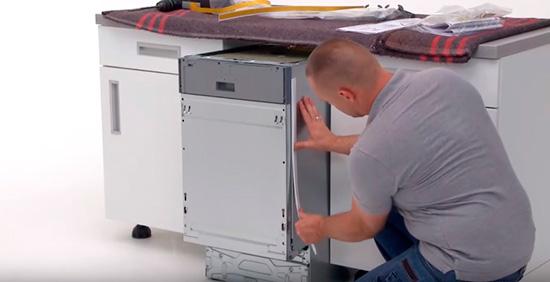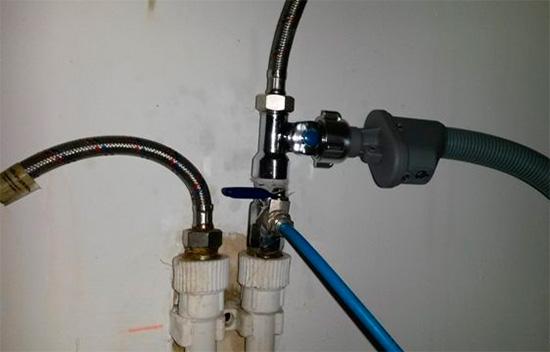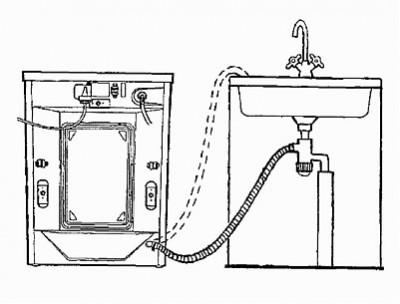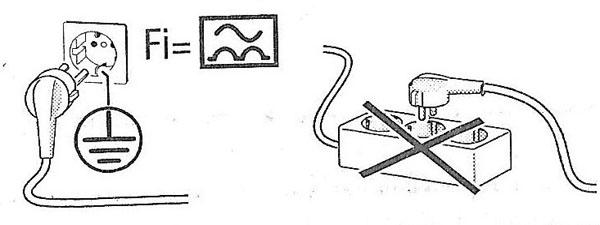When buying a dishwasher, they often try to sell us the services of a master who will install it. This is quite logical, since the master and the store need additional profit. But spending money on these services is not at all necessary, because installation and do-it-yourself dishwasher connection presents no difficulty. You can verify this after reading our instructions.
In fact, the installation and connection process comes down to three relatively simple procedures:
- Electrical connection;
- Insertion into the water supply;
- Drain organization.
All the work can be done with minimal labor costs, and the main difficulty will be embedding the dishwasher in a niche (for built-in models).
Looking for a suitable place to install

Installing a dishwasher begins with finding a suitable location. If you purchased a free-standing model, you can install it anywhere. As for built-in devices, they are mounted in kitchen sets. In both options, you should make sure that water supply and sewerage are located near the equipment. If water can still be carried even into the bedroom, then problems may arise with a distant sewage system - there will be an additional load on the drain pump.
The easiest way is to connect to the electrical network, since it is much easier to bring wires somewhere than to mess with pipes. The main thing is to protect yourself from accidental electric shock - for this you need to follow the safety rules. Once you have completed the process of installing your dishwasher, you can safely start testing it.
Dishwasher installation

Under counter dishwasher installation - a painstaking process. In fact, it begins even before the purchase of the device, as it is necessary measure the installation compartment and calculate its depth. Based on the parameters obtained, we select the appropriate model of the dishwasher. Depending on the width of the section, we can purchase a device with a width of 45 cm or 60 cm. You also need to focus on the depth of the furniture so that the equipment fully enters the niche prepared for it.
How to install a dishwasher in furniture? For this, special fasteners are used, which are equipped with all furniture sets, "sharpened" for the installation of built-in household appliances. If the fastener is located somehow wrong, you can always outweigh it. Installation steps:
- Checking the location of the fasteners;
- Connecting the dishwasher to communications;
- Fixing the dishwasher in a niche;
- Door hanging.
After that, you can start testing.
With a free-standing machine, everything is much simpler - you need to place it anywhere in the kitchen and connect it to the water supply, electricity and sewerage. Just in case, we adjust it according to the level, then making sure that the device is level and without distortions. There are no special vibrations characteristic of washing machines, but it is better to observe the correct installation.
Water connection

You already know how to install a dishwasher of one type or another. Now let's get to the connections. First of all, we will be puzzled by the supply of water.There are four connection methods for consumers to choose from:
- With tie-in tee;
- End connection;
- With collector installation;
- With the installation of a repair clip (bandage).
The most common installation and connection scheme is through a tee. It should be purchased at the nearest plumbing store. It would be convenient if the tee had a built-in ball valve. The tee itself can be metal or plastic. If you will be cutting it into plastic pipes, you may need a special plastic welding tool.
The final connection provides for laying a separate pipe to the dishwasher. It is connected to the water supply with a tee without a tap, and the tap itself is installed at the end of the pipe.This scheme is used when the dishwasher is installed away from the water supply (for safety reasons, it is better to lay a pipe rather than extend the inlet hose - this way you will be safe from leaks).
Connection to the water supply with the installation of a collector is necessary when a large number of consumers are connected to the water supply - this is a washing machine, dishwasher, taps and filters. The collector is designed to clean up and reduce the number of tie-ins into the main pipe - imagine how many tees will need to be installed to connect 5-6 consumers. Therefore, it is easier to put one collector.
Installing a dishwasher using a repair clip is not the best option. This type of connection comes down to installing and fixing a special tee-bandage on a metal pipe. After that, a hole is drilled in the pipe through which water will flow into the dishwasher. The thing is that the rigidity of the pipe decreases in this case, also at the tie-in point, there is a high probability of leakage and blockages.
Sewer connection

Installing and connecting dishwasher water to the sewer is easier than to the water supply. But even here there are certain subtleties. The thing is that we will need to protect the dishwasher from the so-called siphon effect, when the sewer tries to suck water out of the dishwasher - this often leads to equipment failure.. It is also necessary to prevent the penetration of chic sewer "flavors" into the working chamber of the machine.
There are two ways to connect the dishwasher to the sewer:
- With the installation of an "oblique" tee;
- With the installation of a siphon.
The first method is not the most optimal, but in some cases it remains the only available option. For example, when installing your dishwasher away from the sink, where a siphon could be installed. Extending the drain hose is not recommended to avoid additional stress on the drain pump. Then an “oblique” tee crashes into the nearest section of the sewer pipe.
After the installation of the tee is completed, a hose must be connected to it, images of raising and lowering the hose. This is necessary to create reliable protection against the penetration of the contents of the sewer into the working chamber of the dishwasher. In addition, to prevent the siphon effect, it is necessary to install a special anti-siphon valve.
The second option is simpler, more efficient and safer - it involves installing a siphon, which will prevent the siphon effect and prevent sewer odors from entering the dishwasher. Buy a suitable one from a plumbing store siphon with one or two nozzles for connecting equipment and install it under the sink.Connect a hose to it and secure the connection with a metal clamp. This completes the connection process.
Electrical connection

We have come to the final stage of installing and connecting the dishwasher - we just have to bring electricity to it. If there is already an outlet near the installation site, then this is just wonderful, because we just have to plug the plug into it. Please note that dishwashers use Euro plugs, so the old outlet will need to be replaced.
Is the nearest outlet far away from where your washing machine is installed? Then you need to install a new outlet near it, powering it from another outlet or from the nearest junction box. Many specialists it is recommended to install an RCD circuit breaker in front of it. But pulling a separate wire from the switchboard is not at all necessary, since the power of the dishwasher is less than 3 kW - excesses are useless here.
After you complete the installation of the outlet, connect the dishwasher to it, open the central tap, open the ball valve and proceed with the tests. Don't forget to make sure there are no leaks. If there are leaks, tighten the nuts or rewind the fum tape. Now you can load the dishwasher with detergent, salt and rinse aid, place the dishes in it and start the washing program.
As we can see, the process of installing a household dishwasher is extremely simple. If you have the right tools at home (a wrench, a Phillips screwdriver, a hacksaw), then the whole process will take you a couple of hours at most. The price for the installation of a dishwasher starts from 1000-1500 rubles, depending on the region and the complexity of the work.Moreover, this price does not include the cost of additional materials (tees, taps, pipes, etc.). Imagine how much money you can save by doing the installation yourself.
